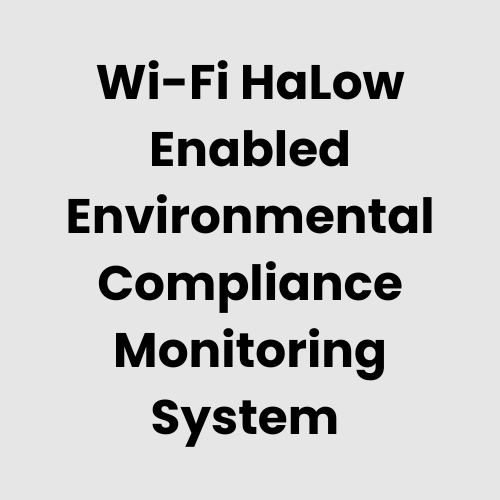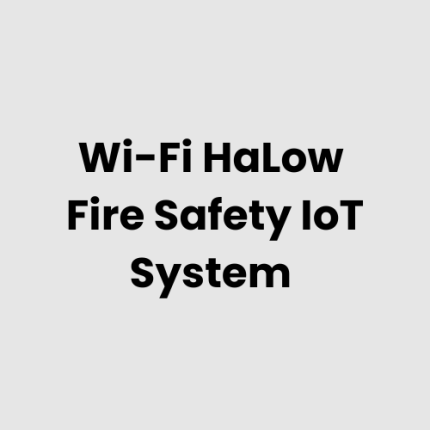Description
Technical Architecture of Wi-Fi HaLow Enabled Environmental Compliance Monitoring System
The Wi-Fi HaLow Enabled Environmental Compliance Monitoring System from GAO Tek Inc. leverages the advantages of Wi-Fi HaLow technology, providing a scalable, low-power, long-range solution ideal for monitoring environmental factors. The system architecture is composed of several key components:
- Sensor Nodes: These are distributed throughout the monitored environment to collect data on environmental parameters such as temperature, humidity, air quality, noise, and pollution levels.
- Wi-Fi HaLow Communication Layer: This layer allows for long-range, low-power data transmission between the sensor nodes and the central server. Wi-Fi HaLow ensures efficient data transfer even in challenging environments.
- Central Monitoring Server: The server aggregates and processes data received from all sensor nodes. It hosts analytics tools, manages storage, and provides real-time data visualizations.
- Cloud Integration: Data can be transmitted to the cloud for further analysis and historical tracking. The cloud offers scalability for data storage and access from multiple locations.
- User Interface: The system provides a dashboard for administrators to monitor environmental data, configure sensors, and receive alerts when thresholds are exceeded.
This robust architecture enables GAO Tek’s system to provide real-time, actionable insights into environmental conditions.
Hardware of Wi-Fi HaLow Enabled Environmental Compliance Monitoring System
The hardware components of the Wi-Fi HaLow Enabled Environmental Compliance Monitoring System are specifically designed to ensure accurate environmental monitoring and seamless communication. These include:
Environmental Sensors:
- Temperature and humidity sensors
- Air quality sensors (PM2.5, CO2, etc.)
- Noise level sensors
- Light and motion sensors
- Pollution sensors (e.g., NO2, SO2)
- Wi-Fi HaLow Communication Modules: These modules enable the sensor nodes to communicate over long distances with minimal power consumption, ensuring reliable data transmission.
- Data Processing Units: These devices receive and process sensor data, preparing it for transmission to the central server or cloud.
- Central Server Hardware: Servers equipped with high-performance processors, ample storage, and necessary software for data processing and analytics.
- Power Supply Units: For field sensors, we integrate solar panels or battery systems to ensure continuous operation in remote locations.
- User Interface Devices: Workstations or mobile devices used by administrators to monitor and interact with the system.
Physical Placement Considerations of the Hardware
To ensure optimal performance of the Wi-Fi HaLow Enabled Environmental Compliance Monitoring System, GAO Tek recommends the following physical placement considerations:
- Sensor Placement: Sensors should be distributed strategically across the monitored area to ensure comprehensive coverage. This may involve placing sensors in areas prone to high environmental fluctuations or in locations that provide a representative sample of the environment.
- Wi-Fi HaLow Coverage: Wi-Fi HaLow operates over longer ranges compared to traditional Wi-Fi. It is essential to ensure that sensor nodes are placed within the range of the wireless network to maintain reliable communication with the central monitoring server.
- Power Management: For battery-powered sensors, select locations with access to natural light or power sources for recharging. For solar-powered systems, ensure sufficient sunlight exposure throughout the day.
- Safety and Durability: Hardware components should be installed in weatherproof enclosures to withstand environmental conditions, particularly in outdoor or industrial applications.
Hardware Architecture of Wi-Fi HaLow Enabled Environmental Compliance Monitoring System
The hardware architecture of GAO Tek’s Wi-Fi HaLow Enabled Environmental Compliance Monitoring System follows a tiered structure:
- Edge Devices (Sensors): These are the foundational components that collect real-time environmental data from various locations.
- Wi-Fi HaLow Communication Network: The sensors send data to a central processing unit via Wi-Fi HaLow technology, which supports extended range and low power consumption.
- Local Data Aggregation Units: In large systems, data from multiple sensors may first be aggregated at local data hubs before being transmitted to the central server for processing. These units can also provide local analytics and decision-making capabilities.
- Centralized Server or Cloud Integration: Once the data is transmitted, it is processed by the central server or the cloud infrastructure for storage, further analytics, and visualization.
This architecture enables seamless integration across different hardware components while maintaining low latency and high reliability.
Deployment Considerations of the Wi-Fi HaLow Enabled Environmental Compliance Monitoring System
When deploying the Wi-Fi HaLow Enabled Environmental Compliance Monitoring System, several factors should be considered to ensure its success:
- Environmental Conditions: Understand the climate and environmental conditions of the deployment area to ensure the hardware is resistant to temperature extremes, humidity, and other potentially damaging factors.
- Network Planning: Careful planning is necessary to ensure adequate Wi-Fi HaLow coverage throughout the deployment area. The system may require additional repeaters or hubs in larger areas to ensure reliable data transmission.
- Scalability: As the monitoring system might need to scale up over time, the architecture must support easy addition of new sensor nodes without disrupting the overall system’s performance.
- Maintenance and Support: Consideration must be given to ongoing maintenance, including battery replacement, sensor calibration, and software updates. Our team at GAO Tek provides continuous support to ensure your system operates efficiently.
List of Relevant Industry Standards and Regulations
- ISO 14001 – Environmental Management Systems
- ISO 9001 – Quality Management Systems
- IEC 61508 – Functional Safety of Electrical/Electronic/Programmable Electronic Safety-Related Systems
- IEEE 802.11ah – Wi-Fi HaLow Standard
- RoHS (Restriction of Hazardous Substances Directive)
- CE Marking for Environmental Compliance
- FCC Regulations (for wireless devices)
- GDPR (General Data Protection Regulation)
Local Server Version of the Wi-Fi HaLow Enabled Environmental Compliance Monitoring System
For customers seeking a more localized solution, GAO Tek’s Wi-Fi HaLow Enabled Environmental Compliance Monitoring System can be deployed with a local server version. This version eliminates the need for cloud infrastructure and allows all data processing and storage to occur within a local data center or on-premise server. This setup is ideal for organizations that require greater control over their data or operate in locations with limited internet access. Our local server version ensures robust security, easy data management, and the flexibility to integrate with existing systems.
Cloud Integration and Data Management
GAO Tek’s Wi-Fi HaLow Enabled Environmental Compliance Monitoring System integrates seamlessly with cloud platforms, enabling remote access to monitoring data, advanced analytics, and long-term storage.
- Real-time Monitoring: Environmental data is sent to the cloud for real-time monitoring and alert generation. This ensures that administrators can access up-to-date information regardless of their physical location.
- Data Storage: The cloud offers virtually unlimited storage capacity for long-term tracking of environmental conditions. This data can be archived, retrieved, and analyzed at any time for compliance or reporting purposes.
- Analytics and Reporting: The cloud platform includes advanced analytics tools that help derive insights from collected data. Automated reports can be generated for compliance audits, environmental assessments, and performance evaluations.
GAO Tek provides full cloud integration capabilities, ensuring that environmental data is easily accessible, secure, and actionable from anywhere.
GAO Case Studies of Environmental Compliance Monitoring
USA Case Studies
- Denver, Colorado: Industrial facilities in Denver employed air quality monitoring systems to ensure compliance with EPA standards. GAO Tek’s cutting-edge IoT sensors help detect and mitigate pollutants in real time, enhancing environmental stewardship. Explore air quality monitoring solutions.
- Houston, Texas: Oil refineries in Houston utilized water monitoring technologies to prevent contamination and maintain compliance with federal water quality regulations. GAO Tek delivers reliable solutions for comprehensive water quality assessments. Learn about water monitoring technologies.
- Los Angeles, California: Factories in Los Angeles implemented noise monitoring systems to comply with OSHA noise exposure standards. GAO Tek provides advanced sound level meters and analytics tools for effective noise management. Discover noise monitoring tools.
- Chicago, Illinois: Waste management facilities in Chicago used IoT-enabled systems to track hazardous material storage, ensuring compliance with environmental safety standards. GAO Tek’s solutions streamline hazardous waste tracking and reporting. Explore hazardous material tracking.
- Phoenix, Arizona: Mining operations in Phoenix integrated soil contamination sensors to monitor heavy metal levels, safeguarding nearby ecosystems. GAO Tek supports industries with robust soil monitoring solutions for environmental compliance. Learn about soil monitoring systems.
- New York City, New York: Construction projects in New York City deployed dust particle monitoring systems to meet local air quality regulations. GAO Tek’s IoT technologies ensure compliance while protecting public health. Explore dust monitoring technologies.
- Seattle, Washington: Port authorities in Seattle implemented waterborne pollutant tracking systems to monitor industrial runoff into the Puget Sound. GAO Tek provides scalable solutions for monitoring waterborne contaminants. Discover water pollutant tracking.
- Miami, Florida: Agricultural operations in Miami adopted nitrate monitoring systems to control fertilizer runoff and comply with water safety standards. GAO Tek offers IoT sensors to optimize agricultural practices sustainably. Learn about nitrate monitoring tools.
- Atlanta, Georgia: Manufacturing plants in Atlanta deployed emissions monitoring technologies to adhere to Clean Air Act regulations. GAO Tek’s solutions empower companies to track and reduce their carbon footprints. Explore emissions monitoring solutions.
- Boston, Massachusetts: Labs in Boston used temperature and humidity sensors to maintain compliance with environmental storage regulations. GAO Tek offers reliable IoT solutions for precise environmental monitoring. Learn about temperature monitoring systems.
- Las Vegas, Nevada: Casinos in Las Vegas implemented energy monitoring systems to align with state sustainability mandates. GAO Tek supports energy management initiatives with IoT-enabled monitoring tools. Discover energy monitoring solutions.
- Portland, Oregon: Breweries in Portland monitored water usage to meet local conservation policies, reducing their environmental impact. GAO Tek delivers innovative tools for water resource management. Learn about water usage monitoring.
- San Francisco, California: Data centers in San Francisco installed heat dissipation monitoring systems to ensure compliance with state energy efficiency standards. GAO Tek offers IoT solutions to optimize cooling and energy use. Explore energy efficiency monitoring.
- Dallas, Texas: Transportation hubs in Dallas used real-time air quality monitoring to protect public health and meet EPA guidelines. GAO Tek’s air quality solutions offer actionable insights for compliance. Discover real-time air monitoring.
- Philadelphia, Pennsylvania: Industrial warehouses in Philadelphia implemented VOC detection systems to adhere to emissions limits. GAO Tek’s monitoring technologies help businesses meet strict environmental regulations. Learn about VOC monitoring tools.
Canada Case Studies
- Toronto, Ontario: Wastewater treatment plants in Toronto adopted IoT systems for real-time monitoring of effluent quality, ensuring compliance with national water standards. GAO Tek’s robust IoT solutions support environmental sustainability in Canada. Explore wastewater monitoring technologies.
- Vancouver, British Columbia: Forestry operations in Vancouver utilized soil erosion monitoring tools to maintain compliance with government reforestation policies. GAO Tek’s technologies enable sustainable land management practices. Learn about soil erosion monitoring.
Navigation Menu for Wi-Fi HaLow
- Wi-Fi HaLow Gateways/Routers
- Wi-Fi HaLow End Devices
- Wi-Fi Halow – Cloud, Server, PC & Mobile Systems
- Wi-Fi HaLow Accessories
Navigation Menu for IoT
- LORAWAN
- Wi-Fi HaLow
- Z-WAVE
- BLE & RFID
- NB-IOT
- CELLULAR IOT
- GPS IOT
- IOT SENSORS
- EDGE COMPUTING
- IOT SYSTEMS
Our products are in stock and can be shipped anywhere in the continental U.S. or Canada from our local warehouse. For any further information, please fill out this form or email us.
We are looking for partners. For more information on partnering with GAO, please visit Partner with GAO Tek Inc. It lists various ways to partner with GAO, such as OEM Partnerships, Technology Integration, Distribution and Reselling Opportunities, Presenting at the Leading Event TekSummit, Joint R&D Projects, Training and Consulting Services, Industry-Specific Collaborations, Research and Academic Partnerships.
This webpage has been developed by James R.A and approved by Mcline C.A pursuant to GAO Web Content Development Process and Policy.



